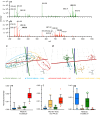Testing of rapid evaporative mass spectrometry for histological tissue classification and molecular diagnostics in a multi-site study
- PMID: 39294437
- PMCID: PMC11473823
- DOI: 10.1038/s41416-024-02739-y
Testing of rapid evaporative mass spectrometry for histological tissue classification and molecular diagnostics in a multi-site study
Abstract
Background: While REIMS technology has successfully been demonstrated for the histological identification of ex-vivo breast tumor tissues, questions regarding the robustness of the approach and the possibility of tumor molecular diagnostics still remain unanswered. In the current study, we set out to determine whether it is possible to acquire cross-comparable REIMS datasets at multiple sites for the identification of breast tumors and subtypes.
Methods: A consortium of four sites with three of them having access to fresh surgical tissue samples performed tissue analysis using identical REIMS setups and protocols. Overall, 21 breast cancer specimens containing pathology-validated tumor and adipose tissues were analyzed and results were compared using uni- and multivariate statistics on normal, WT and PIK3CA mutant ductal carcinomas.
Results: Statistical analysis of data from standards showed significant differences between sites and individual users. However, the multivariate classification models created from breast cancer data elicited 97.1% and 98.6% correct classification for leave-one-site-out and leave-one-patient-out cross validation. Molecular subtypes represented by PIK3CA mutation gave consistent results across sites.
Conclusions: The results clearly demonstrate the feasibility of creating and using global classification models for a REIMS-based margin assessment tool, supporting the clinical translatability of the approach.
© 2024. Waters Technologies Corporation and The Author(s).
Conflict of interest statement
Waters Corporation provided supplies and maintenance for the mass spectrometry equipment used. JB and SDP are employed by Waters. The remaining authors declare no competing interests.
Figures




References
-
- Balog J, Szaniszlo T, Schaefer K-C, Denes J, Lopata A, Godorhazy L, et al. Identification of biological tissues by rapid evaporative ionization mass spectrometry. Anal Chem. 2010;82:7343–50. - PubMed
-
- Balog J, Sasi-Szabó L, Kinross J, Lewis MR, Muirhead LJ, Veselkov K, et al. Intraoperative tissue identification using rapid evaporative ionization mass spectrometry. Sci Transl Med. 2013;5:194ra93. - PubMed
-
- Leff DR, St John ER, Takats Z. Reducing the margins of error during breast-conserving surgery: disruptive technologies or traditional disruptions? JAMA Surg. 2017;152:517–8. - PubMed
-
- Balog J, Kumar S, Alexander J, Golf O, Huang J, Wiggins T, et al. In vivo endoscopic tissue identification by rapid evaporative ionization mass spectrometry (REIMS). Angew Chem Int Ed Engl. 2015;54:11059–62. - PubMed
Publication types
MeSH terms
Substances
LinkOut - more resources
Full Text Sources
Medical
Miscellaneous

